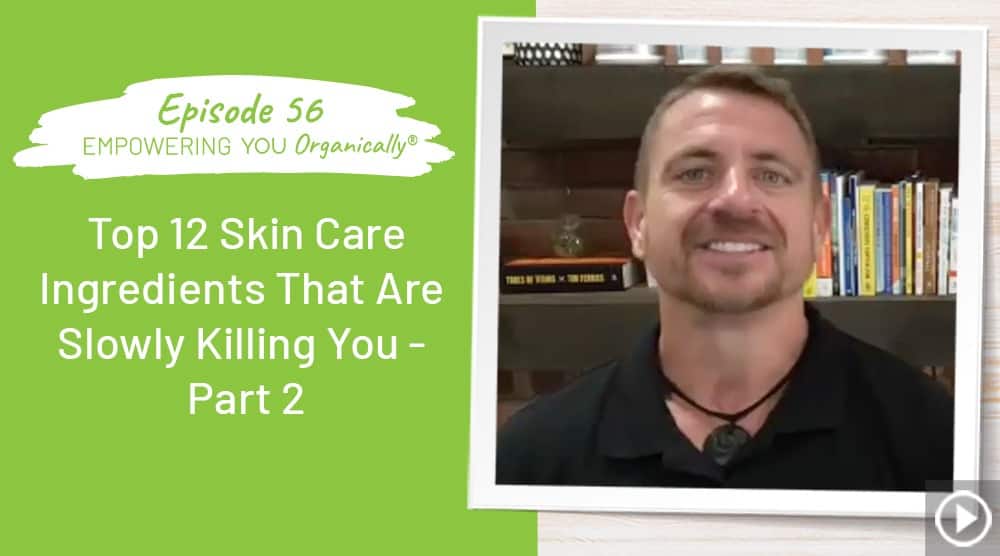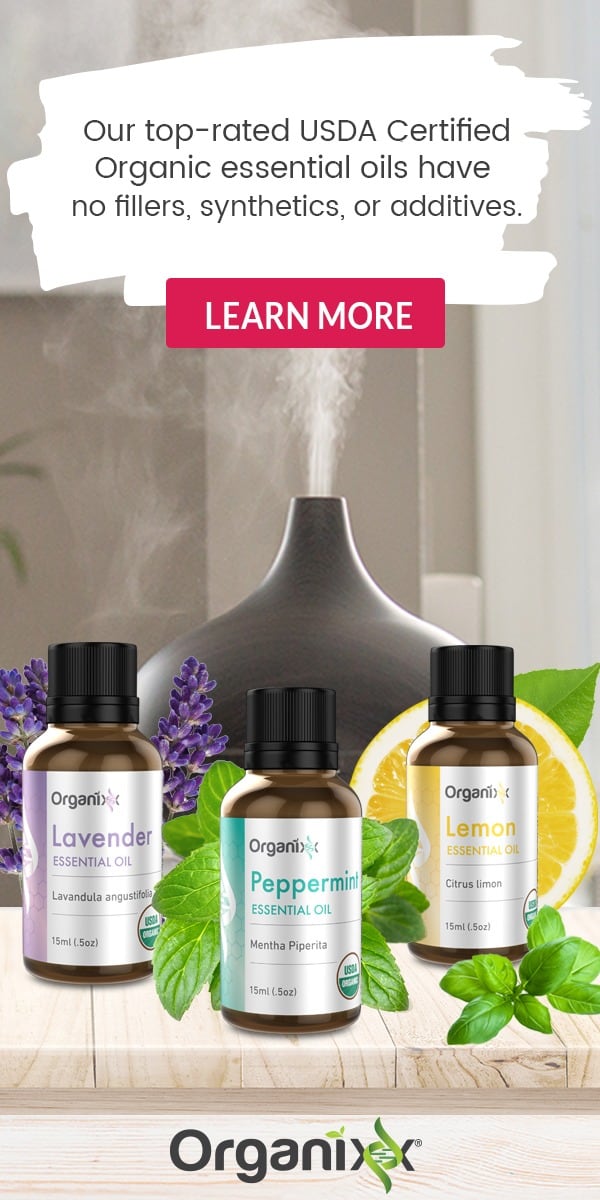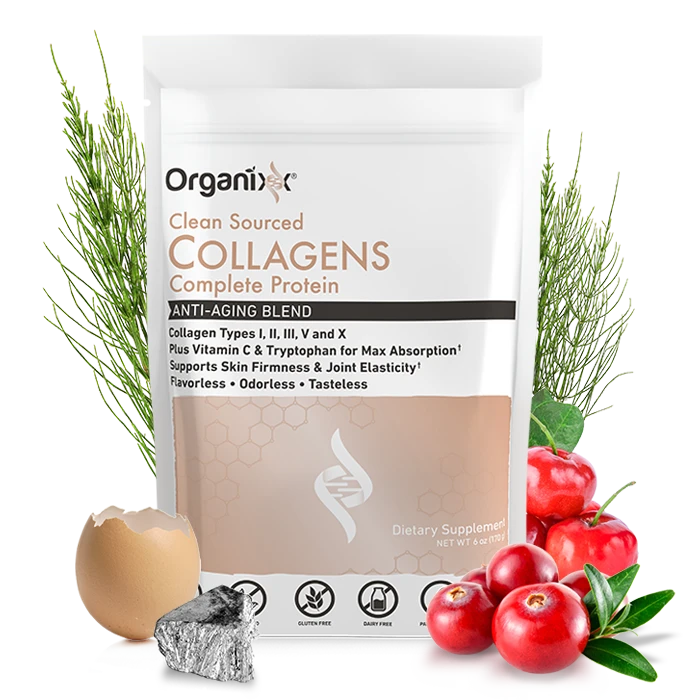Empowering you Organically – Season 7 – Episode 56
Title: Top 12 Skincare Ingredients That Are Slowly Killing You – Part 2
Hosts: Jonathan Hunsaker, TeriAnn Trevenen
Description: The beauty industry isn’t so beautiful. Last week we covered the first 6 toxic ingredients to avoid in your skincare products. This week we tackle the remaining 6. How many products in your cabinets contain these ingredients? Please listen in – educate yourself for your health and peace of mind.
Featured Product
Powerful Proteins Help Smooth Wrinkles, Keep Skin Plump, and Promote Joint Health
- FOUR COLLAGEN SOURCES: We’ve combined collagen types I, II, III, V and X – the major types of collagen your body needs – from four different sources (grass-fed cows, wild-caught fish, antibiotic-free chicken, eggshell membrane) for the ultimate matrix of health benefits.
- HIGHLY BIOAVAILABLE: Clean Sourced Collagen is formulated with VItamin C, Horsetail Extract and Zinc for maximum absorption.
- EASY TO TAKE: Our revolutionary, odorless, tasteless, and easy-to-mix Clean Sourced Collagens can be added to a wide variety of healthy foods or mixed into water, juice, or your favorite smoothie.
- NATURAL INGREDIENTS: We only use the purest ingredients found on Earth and our supplements are free from artificial flavors, preservatives, colors, yeast, soy protein, sodium, starch and are non-GMO.
* * *
Why Skincare Impacts Your Health
- Skin is the biggest organ on your body.
- Skin absorbs everything that we put on it.
- Skincare is one of the most lucrative industries in the world.
“Fake Skincare”
- In March of 2019, the Environmental Working Group, the EWG, reported that US regulation of chemicals and contaminants in cosmetics is falling behind the rest of the world.
- More than 40 nations, ranging from major industrialized economies like the United Kingdom and Germany to developing states like Cambodia and Vietnam, have enacted regulations specifically targeting the safety and ingredients of cosmetics and personal care products.
- Some of these nations have restricted or completely banned more than 1,400 chemicals from cosmetic products.
- By contrast, the US Food and Drug Administration has banned or restricted only 9 chemicals for safety reasons.
- This is one of the most under-regulated industries but one of the most lucrative industries in the United States.
Why Do Regulations Matter?
- The Environmental Working Group (EWG)
- They curate the Skin Deep database of ingredients used in personal care products and their safety concerns on human health.
- Biggest advocates for clean ingredients in your products.
- If your skincare product is backed by the EWG, it means they’ve done their homework, they’ve taken the time to look at clean ingredients.
- The EWG has a scale that rates products from 1 to 5 as far as cleanliness and safety.
Top 12 Ingredients to Avoid & Why
| Ingredient | Typically Found In: | Why You Should Avoid |
| DEA COMPOUNDS (DIETHANOLAMINE)
|
DEA and DEA compounds are used to make cosmetics creamy or sudsy.
|
These cause mild skin and eye irritation. Exposure to high doses of these chemicals has caused liver cancers and pre-cancerous changes in skin and thyroid. DEA is also possible hormone disruptor, has shown limited evidence of carcinogenicity and depletes the body of choline needed for fetal brain development. |
| FRAGRANCE/PARFUM
|
Apart from being used in perfumes and deodorants, they are used in nearly every type of personal-care product. Of the thousands of chemicals used in fragrances, most have not been tested for toxicity, alone or in combination. Over 3000 chemicals are used to manufacture synthetic fragrances.
|
These are often unlisted ingredients that are irritants and can trigger allergies, migraines, and asthma symptoms. The catchall term “fragrance” may mask phthalates, which act as endocrine disruptors and may cause obesity and reproductive and developmental harm. In laboratory experiments, individual fragrance ingredients have been associated with cancer and neurotoxicity.
Federal law doesn’t require companies to list on product labels any of the chemicals in their fragrance mixture. Recent research from Environmental Working Group and the Campaign for Safe Cosmetics found an average of 14 chemicals in 17 name-brand fragrance products, none of them listed on the label. |
| PEG COMPOUNDS (POLYETHYLENE GLYCOLS)
|
Found in: scrubs, body wash, makeup, toothpaste
PEGs are widely used in cosmetics as thickeners, solvents, softeners, and moisture-carriers and hence used for products requiring a cream base and also in laxatives.
|
Those tiny plastic beads in face or lip scrubs and exfoliating washes are made from polyethylene (used because they’re gentler on the skin than natural exfoliators like walnut shells). These synthetic chemicals are frequently contaminated with 1,4-dioxane, which the U.S. government considers a probable human carcinogen and which readily penetrates the skin. Polyethylene has been noted as a skin irritant and should never be used on broken skin. Polyethylene beads in scrubs and body washes also are not filtered by our sewage systems, meaning they can collect pollutants and travel into waterways, where they’re consumed by fish and marine animals. |
| PETROLATUM
|
Petrolatum, also known as petroleum jelly, is used in industry to lubricate machinery – so what is it doing to our bodies? Petrolatum has been used for years to lock in moisture, heal chapped lips, soothe noses raw from sniffles, and protect against diaper rash, as well as to treat cuts and burns. It is an ingredient in one out of every 14 cosmetic products on any given shelf, which includes 15 percent of lipsticks and 40 percent of baby products. So what’s the big deal? | Scarily enough, petroleum byproduct has been found in breast tumors, strongly suggesting it is a breast-cancer-promoting substance. It also suffocates the skin, blocking oxygen absorption and aggravating acne. Petrolatum locks in moisture, yes – but does not allow moisture to be absorbed from the atmosphere. In short, our body gets accustomed to petrolatum’s barrier and slowly become less and less efficient at its own detoxifying and moisturizing processes.
|
| TRICLOSAN
|
Triclosan is used mainly in antiperspirants/deodorants, cleansers, and hand sanitizers as a preservative and an anti-bacterial agent. Also used in laundry detergent, facial tissues, and antiseptics for wounds. Triclosan is classified as a pesticide.
|
Triclosan was all the rage as antibacterial products became ubiquitous in the 1990s.
But…it can pass through skin and can affect the body’s hormone systems—especially thyroid hormones, which regulate metabolism—and may disrupt normal breast development. Widespread use of triclosan may also contribute to bacterial resistance to antimicrobial agents.
It acts like estrogen in the body and has high rates of skin allergy. (High toxicity concern.)
The Canadian Medical Association has called for a ban on antibacterial consumer products, such as those containing triclosan.
Even the FDA agrees that there is no health benefit to humans who use triclosan, and in 2013 ruled that manufacturers using it had to demonstrate that there were no long-term detrimental effects.
We personally use naturally antibacterial and antiseptic agents like tea tree oil. |
| SILOXANES
Siloxanes are a group of chemicals that are, as the name suggests, derived from silicone. |
Cyclomethicone and ingredients ending in “siloxane” make hair products dry quickly and deodorant creams slide on easily.
They are also used extensively in moisturizers and facial treatments to soften and smoothen and in medical implants. |
The risks associated with siloxanes are far too many. Siloxanes are known endocrine disruptors that interfere with human hormone function, and could even possibly impair fertility. Research has shown that they not only cause uterine tumors, but can also skew the functioning of neurotransmitters in the nervous system. On top of that, siloxanes resist degradation and therefore pose harm to aquatic life and wildlife. |
| PHTHALATES (DIBUTYL PHTHALATE)
|
nail polish and other nail products, perfume, makeup remover, hairspray, deodorant
|
Phthalates are sneaky endocrine disruptors, which means they mimic the body’s hormones, therefore throwing the entire endocrine system off balance. They cause both hormonal and neurological damage, and in the case of pregnant women, may also cause major birth defects. The worst part? You will rarely find the word “phthalates” on a label.
Some products do market themselves as phthalate-free, but what about the other slew of synthetics on our department store’s beauty shelf? You can identify phthalates by their abbreviated chemical components: DBP (di-n-butyl phthalate), DEP (diethyl phthalate), DMP (dimethyl phthalate), DEHP (di-2-ethylhexyl), and BzBP (benzylbutyl phthalate). |
| SULPHATES (SODIUM LAURATE, LAURYL SULPHATE OR SLS)
|
Primarily used as a foaming agent or detergent to be found in shampoos, facial cleansers, mouthwash, toothpaste, bubble bath products, household and utensil cleaning detergents.
|
Depending on the manufacturing process, Sodium laureth sulfate may be contaminated with ethylene oxide and 1,4-dioxane. Both contaminants may cause cancer. Also, ethylene oxide may harm the nervous system and interfere with human development, and 1,4-dioxane is persistent. In other words, it doesn’t easily degrade and can remain in the environment long after it is rinsed down the shower drain.
SLS has been shown to cause or contribute to: skin irritation, canker sores, disruptions of skin’s natural oil balance and eye damage. It is also widely believed to be a major contributor to acne (especially cystic acne) around the mouth and chin. |
| PARABENS (METHYL-, ETHYL-, PROPYL-, BUTYL-, ISOBUTYL-)
|
A common and very cheap cosmetic preservative, the second most common skincare ingredient.
Found in: makeup, moisturizer, shaving gel, shampoo, personal lubricant and spray tan products
|
Synthetic parabens are toxic in large or cumulative quantities, as the body stores parabens in many tissue types. They can cause allergic reactions, skin rashes and irritation. Parabens have been shown to mimic estrogen which disrupts normal hormone function. Exposure to external estrogen’s have been shown to increase the risk of breast cancer and increase cell abnormalities. There should be no excuse for your skincare products to still have Parabens.
The FDA acknowledges several studies linking parabens, which mimic estrogen, to breast cancer, skin cancer and decreased sperm count, but has not ruled that it is harmful. According to the European Commission’s Scientific Committee on Consumer Products, longer chain parabens like propyl and butyl paraben and their branched counterparts, isopropyl and isobutylparabens, may disrupt the endocrine system and cause reproductive and developmental disorders. Look for ingredients with the suffix “-paraben” as well—paraben-free products will be labeled as such. |
| FORMALDEHYDE
|
These are primarily preservatives commonly found in cosmetics. It is also found in baby bath soap, nail polish, eyelash adhesive and hair dyes. Look for: DMDM hydantoin, diazolidinyl urea, imidazolidinyl urea, methenamine, quaternium-15, and sodium hydroxymethylglycinate. These ingredients slowly and continuously release small amounts of formaldehyde.
|
Short-term health impacts include irritation to the eyes, nose and throat, and many studies show it causes allergic skin reactions and skin rashes. In fact, it was awarded 2105 Contact Allergen of the Year by American Contact Dermatitis Society.
Long term, Formaldehyde has a long list of adverse health effects, including immune-system toxicity, respiratory irritation and cancer in humans. Formaldehyde is a recognized human carcinogen.
|
| BHA AND BHT (BUTYLATED HYDROXYANISOLE AND BUTYLATED HYDROXYTOLUENE)
|
Butylated hydroxytoluene (BHT) and butylated hydroxyanisole (BHA) are closely related chemicals – preservatives commonly used in cosmetics, personal care products (mainly shampoos, perfumes, deodorants, body lotions), and even food and food packaging.
|
The National Toxicology Program classifies butylated hydroxyanisole (BHA) as “reasonably anticipated to be a human carcinogen.” It can cause skin depigmentation. In animal studies, BHA produces liver damage and causes stomach cancers such as papillomas and carcinomas and interferes with normal reproductive system development and thyroid hormone levels. The European Union considers it unsafe in fragrance. Opt for a BHA and phthalate-free perfume. |
| COAL-TAR DYES
Polycyclic aromatic hydrocarbons (PAHs) are a group of chemicals that occur naturally in coal, crude oil and gasoline.
|
Found in: hair dyes, lipstick, cosmetic, shampoo
|
Phenylenediamine, used in hair dyes, has been found to be carcinogenic in laboratory tests conducted by the U.S. National Cancer Institute and National Toxicology Program. Coal tar is recognized as a human carcinogen and the main concern are their potential as carcinogens. As well, colors may be contaminated with low levels of heavy metals and some contain aluminum (a neurotoxin). This is of particular concern when used in cosmetics that may be ingested, like lipstick.
|
* * *
Subscribe to Empowering You Organically
Never miss an episode!
APPLE PODCASTS SPOTIFY GOOGLE PODCASTS
–
Episode 56 – Top 12 Skincare Ingredients That Are Slowly Killing You – Part 2





